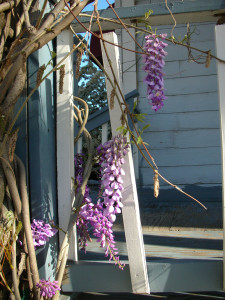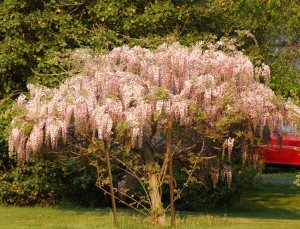Hello fellow readers,
I visited Kathleen and Andrew in Summit and witnessed first-hand the strength of their dilemma devastating their deck. The wrist-thick woody vine climbing from the ground to their second-story deck was strong and impressive. It wasn’t in bloom as yet, and they admitted flowers had been few and far between. Indeed wisteria needs something beefy to climb onto, as it can be destructive.
Wisteria is a genus of about ten species. Eight are Asian, including Japanese wisteria (Wisteria floribunda) and Chinese wisteria (Wisteria senensis). The barely fragrant American wisteria (Wisteria frutescens) is recommended as an alternative to the Asian species on the USDA list of invasive plants.
You’ve likely seen wisteria climbing in trees, and when in bloom in May, it’s a spectacular show. But it also can strangle even a large tree. Instead, it’s best to stand alone. A Wisteria tree is typically made by grafting a wisteria vine on top of a standard tree trunk.
Wisteria flowers are best when they receive at least 6 hours of full sun daily. They thrive in most soil types as long as it’s well-drained in zones 5 to 9.
The first year after planting, they need at least one inch of water per week to speed establishment. Once established, water sparingly. They require little, if any, fertilizing. In fact, a reason for failure to bloom can be excessive fertilizer, particularly nitrogen. Wisteria can also be reluctant to bloom because it has not reached maturity. A newly established plant can take six or more years to flower.
Pruning is the other secret to good flowering. Remove at least half of the prior year’s growth in late winter, leaving just a few buds per stem. If you want a more formal appearance, prune again during summer after flowering. They say for even more blooms, cut back the rampant shoots every two weeks during the summer.
Don’t worry if you give your wisteria a lousy haircut; they are very forgiving. And next season, rambling growth will provide you with a second chance.
Garden Dilemmas? AskMaryStone@gmail.com and your favorite Podcast App.
Column updated 5/20/23




